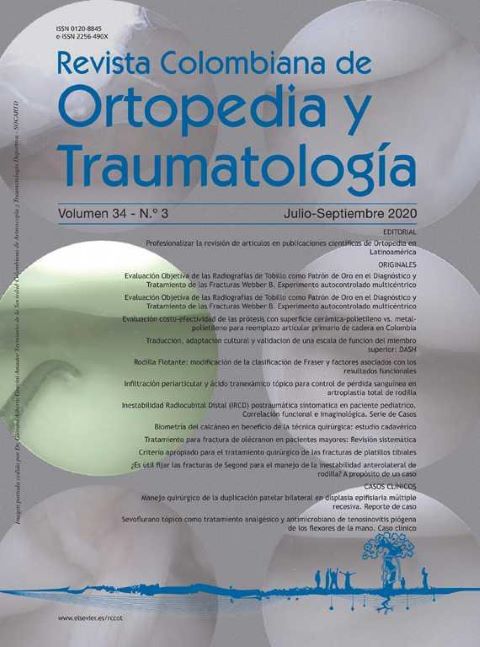Surgical management of bilateral duplication of the patella in multiple recessive epiphyseal dysplasia. A case report
DOI:
https://doi.org/10.1016/j.rccot.2020.07.004Keywords:
patella, multiple epiphyseal dysplasia, osteochondrodysplasias, kneeAbstract
Background: Multiple epiphyseal dysplasia (MED) is a rare disease with a great clinical variation, and is characterised by deformities in the joints, pain, and gait disorders. Duplication of the patella is associated with recessive MED, and consists of two staggered patellar segments separated by soft tissue between them.
Clinical case: A 30-years-old male patient with a clinical manifestation of recessive MED with duplication of the patella, chronic bilateral hip and knee pain, as well as gait disorder. After the physical examination, joint effusion, difficulty in flexing the knees, and a bilateral intraarticular free body were evident. Two patellar segments, acetabular dysplasia and bilateral femoral head, were identified with diagnostic imaging. The surgical management of duplication of the patella was resection of the accessory bone segments, leading to a satisfactory clinical result at one year of follow-up.
Discussion: Although the genetic diagnosis of the MED was not made, our patient presented with the phenotypic and radiological characteristics of this disease. For duplication of the patella, the accessory patella resection was performed, considering the high risk of non-union. However, there are several reports where the two patellar segments are joined; but mainly in children. This is the first report published about the surgical management of this pathology in Colombia. Duplication of the patella can be managed successfully by resecting accessory patella in adults. Although the imaging findings are very suggestive of this pathology, an adequate physical examination is required to avoid a false and late diagnosis.
Evidence Level: IV
Downloads
References
Goebel S, Steinert AF, Barthel T. Surgical management of a double-layered patella: A case report. Arch Orthop Trauma Surg. 2009;129:1071-5, doi:10.1007/s00402-008-0701-z.
Nakashima E, Ikegawa S, Ohashi H, Kimizuka M, Nishimura G. Double-layered patella in multiple epiphyseal dysplasia is not exclusive to DTDST mutation. Am J Med Genet Part A. 2005;133A:106-7, http://dx.doi.org/10.1002/ajmg.a.30481.
Hinrichs T, Superti-Furga A, Scheiderer W-D, Bonafé L, Brenner RE, Mattes T. Recessive multiple epiphyseal dysplasia (rMED) with homozygosity for C653S mutation in the DTDST gene - Phenotype, molecular diagnosis and surgical treatment of habitual dislocation of multilayered patella: Case report. BMC Musculoskelet Disord. 2010;11:110, doi:10.1186/1471-2474-11-110.
Minh D, Nguyen, Joshua S, Everhart, Megan M, May DCF. Bilateral Double-Layered Patella: MRI Findings and Fusion with Multiple Headless Screws. J BONE Jt Surg. 2013:3-6, doi:https://doi.org/10.2106/JBJS.CC.L.00314.
Miura H, Noguchi Y, Mitsuyasu H, Nagamine R, Urabe K, Matsuda S, Iwamoto Y. Clinical Features of Multiple Epiphyseal Dysplasia Expressed in the Knee. Clin Orthop Rel at Res. 2000:184-90, doi: 10.1097/00003086-200011000-00025.
Yochum TR, Sprowl CG, Barry MS. Double patella syndrome with a form of multiple epiphyseal dysplasia. J Manipulative Physiol Ther. 18(6):407-410.
Milants A, De Maeseneer M, De Mey J. Double-Layered Patella (DLP) in Multiple Epiphyseal Dysplasia (MED). J Belgian Soc Radiol. 2017;101(1.):1219, doi:10.5334/jbr-btr.
Oscar Marrero Riverón L, Osana Vilma Rondón García I, Liván Pena˜ Marrero I, et al. Rótula bicapa bilateral. Rev Cubana Ort Traum. 2017;31:2017, http://scielo.sld.cu.
Vatanavicharn N, Lachman RS, Rimoin DL. Multilayered patella: Similar radiographic findings in pseudoachondroplasia and recessive multiple epiphyseal dysplasia. Am J Med Genet Part A. 2008;146A:1682-6, http://dx.doi.org/10.1002/ajmga.32313.
Superti-Furga A, Neumann L, Riebel T, et al. Recessively inherited multiple epiphyseal dysplasia with normal stature, club foot, and double layered patella caused by a DTDST mutation. J Med Genet. 2003;36:621-4, doi:10.1136/jmg.40.1.65.
Rossi A, Superti-Furga A. Mutations in the diastrophic dysplasia sulfate transporter (DTDST) gene (SLC26A2): 22 novel mutations, mutation review, associated skeletal phenotypes, and diagnostic relevance. Hum Mutat. 2001;17:159-71, doi:10.1002/humu.1.
Mäkitie O, Savarirayan R, Bonafé L, et al. Autosomal recessive multiple epiphyseal dysplasia with homozygosity for C653S in the DTDST gene: Double-layer patella as a reliable sign. Am J Med Genet Part A. 2003;122A:187-92, http://dx.doi.org/10.1002/ajmg.a.20282.
Ballhausen D, Bonafé L, Terhal P, et al. Recessive multiple epiphyseal dysplasia (rMED): phenotype delineation in eighteen homozygotes for DTDST mutation R279W. J Med Genet. 2003;40:65-71, doi:10.1136/JMG.40.1.65.
Y. Chen, M. Khanna MWL. Congenital variations of the patella with distinguishing features. http://posterng.netkey.at/essr/viewing/index.php?module=viewingposter&task=&pi=118375. Published 2013.
Bonafé L, Mittaz-Crettol L, Ballhausen D, Superti-Furga A. Multiple Epiphyseal Dysplasia, Recessive. University of Washington. Seattle. 2014, http://www.ncbi.nlm.nih.gov/pubmed/20301483.





